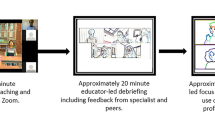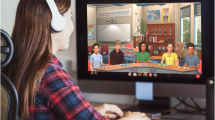Abstract
The challenge of preparing novice primary teachers for teaching in an educational environment, where science education has low status and many teachers have limited science content knowledge and lack the confidence to teach science, is great. This paper reports on an innovation involving a sustained simulation in an undergraduate science education course as a mediational tool to connect two communities of practice—initial teacher education and expert primary science teaching. The course lecturer and student teachers role-played the expert classroom teacher and primary students (Years 7/8) respectively in an attempt to gain insights into teaching and learning through authentic activity that models good practice in primary science teaching and learning. Activity theory was used to help frame and analyse the data. Findings from the first trial indicate that the simulation was very effective in initiating science pedagogical content knowledge (PCK) development of primary student teachers.


Similar content being viewed by others
References
Australian Academy of Science. (2005). Primary connections. Stage 2 trial: Research report. Canberra: Australian Academy of Science.
Bell, J. (1999). Doing your research project. Berkshire: Open University Press.
Brown, J., Collins, A., & Duguid, P. (1980). Situated cognition and the culture of learning. Educational Researcher, 18(1), 32–42.
Bryman, A. (2008). Social research methods (3rd ed.). New York: Oxford University.
Bybee, R. W. (1997). Achieving scientific literacy: from purposes to practices. Portsmouth: Heinemann.
Cohen, L., Manion, L., & Morrision, K. (2007). Research methods in education (6th ed.). New York: Routledge.
Creswell, J. W. (2005). Educational research. Planning, conducting, and evaluating quantitative and qualitative research. New Jersey: Pearson Education.
Engeström, Y. (1999). Activity theory and individual and social transformation. In Y. Engeström, R. Miettinin, & R. Punamäki (Eds.), Perspectives on activity theory (pp. 19–38). New York: Cambridge University Press.
Erikson, F. (1998). Qualitative research methods for science education. In B. J. Fraser & K. G. Tobin (Eds.), International handbook of science education (pp. 1155–1174). Dordrecht: Kluwer.
Girod, M., & Girod, G. (2006). Exploring the efficacy of the Cook School District simulation. Journal of Teacher Education, 57(5), 481–497.
Grossman, P. L. (1990). Making of a teacher: teacher knowledge and teacher education. New York: Teachers College.
Guba, E., & Lincoln, Y. (1989). Fourth generation evaluation. Newbury Park: Sage.
Hipkins, R., & Bolstad, R. (2008). Seeing yourself in science. The importance of the middle school years. Wellington: NZCER.
Hung, D., Tan, S., & Koh, T. (2006). From traditional to constructivist epistemologies: a proposed theoretical framework based on activity theory for learning communities. Journal of Interactive Learning Research, 17(1), 37–55.
Keeves, J. P. (1998). Methods and processes in research in science education. In B. Fraser & K. Tobin (Eds.), International handbook of science education (pp. 1127–1153). Dordrecht: Kluwer.
Kenny, J. (2010). Preparing pre-service primary teachers to teach primary science: a partnership-based approach. International Journal of Science Education, 32(10), 1267–1288.
Lave, J., & Wenger, E. (1991). Situated learning: legitimate peripheral participation. Cambridge: Cambridge University Press.
Leach, J., & Scott, P. (2003). Individual and sociocultural views of learning in science education. Science & Education, 12, 91–113. education.
Loughran, J., Mulhall, P., & Berry, A. (2008). Exploring pedagogical content knowledge in science teacher education. International Journal of Science Education, 30(10), 1301–1320.
Lloyd, J. K., Smith, R. G., Fay, C. L., Khang, G. N., Wah, L. L. K., & Sai, C. L. (1998). Subject knowledge for science teaching at primary level: a comparison of pre-service teachers in England and Singapore. Internationl Journal of Science Education, 20(5), 521–532.
Magnusson, S., Krajcik, J., & Borko, H. (1999). Nature, sources, and development of pedagogical content knowledge for science teaching. In J. Gess-Newsome & N. G. Lederman (Eds.), Examining pedagogical content knowledge: the construct and its implications for science education (pp. 95–132). Boston: Kluwer.
Ministry of Education. (2007). The New Zealand curriculum. Wellington: Learning Media.
Moon, J. A. (1999). Learning journals. A handbook for academics, students and professional development. London: Kogan Page.
Nilsson, P. (2008). Teaching for understanding: the complex nature of pedagogical content knowledge in pre-service education. International Journal of Science Education, 30(10), 1281–1299.
Nilsson, P., & van Driel, J. (2010). How will we understand what we teach?—Primary student teachers’ perceptions of their development of knowledge and attitudes towards physics. Research in Science Education. doi:10.1007/s11165-010-9179-0.
Patton, M. Q. (1990). Qualitative evaluation and research methods. Newbury Park: Sage.
Putnam, R. T., & Borko, H. (2000). What do new views of knowledge and thinking have to say about research on teacher learning? Educational Researcher, 29(1), 4–15.
Resnick, L. B. (1987). Learning in school and out. Educational Researcher, 19(9), 13–20.
Rice, D. C. (2005). I didn’t know oxygen can boil! What preservice and inservice elementary teachers’ answers to ‘simple’ science questions reveal about their subject matter knowledge. International Journal of Science Education, 27(9), 1059–1082.
Shulman, L. (1987). Knowledge and teaching: foundations of the new reform. Harvard Educational Review, 57(1), 1–22.
The Royal Society. (2010). Science and mathematics education, 5–14. A ‘state of the nation’ report. London: The Royal Society.
Tytler, R., Osborne, J. F., Williams, G., Tytler, K., & Cripps Clark, J. (2008). Opening up pathways: Engagement in STEM across the primary-secondary school transition. A review of the literature concerning supports and barriers to Science, Technology, Engineering and Mathematics engagement at primary-secondary transition. Canberra: Commissioned by the Australian Department of Education, Employment and Workplace Relations.
Author information
Authors and Affiliations
Corresponding author
Rights and permissions
About this article
Cite this article
Hume, A.C. Primary Connections: Simulating the Classroom in Initial Teacher Education. Res Sci Educ 42, 551–565 (2012). https://doi.org/10.1007/s11165-011-9210-0
Published:
Issue Date:
DOI: https://doi.org/10.1007/s11165-011-9210-0




